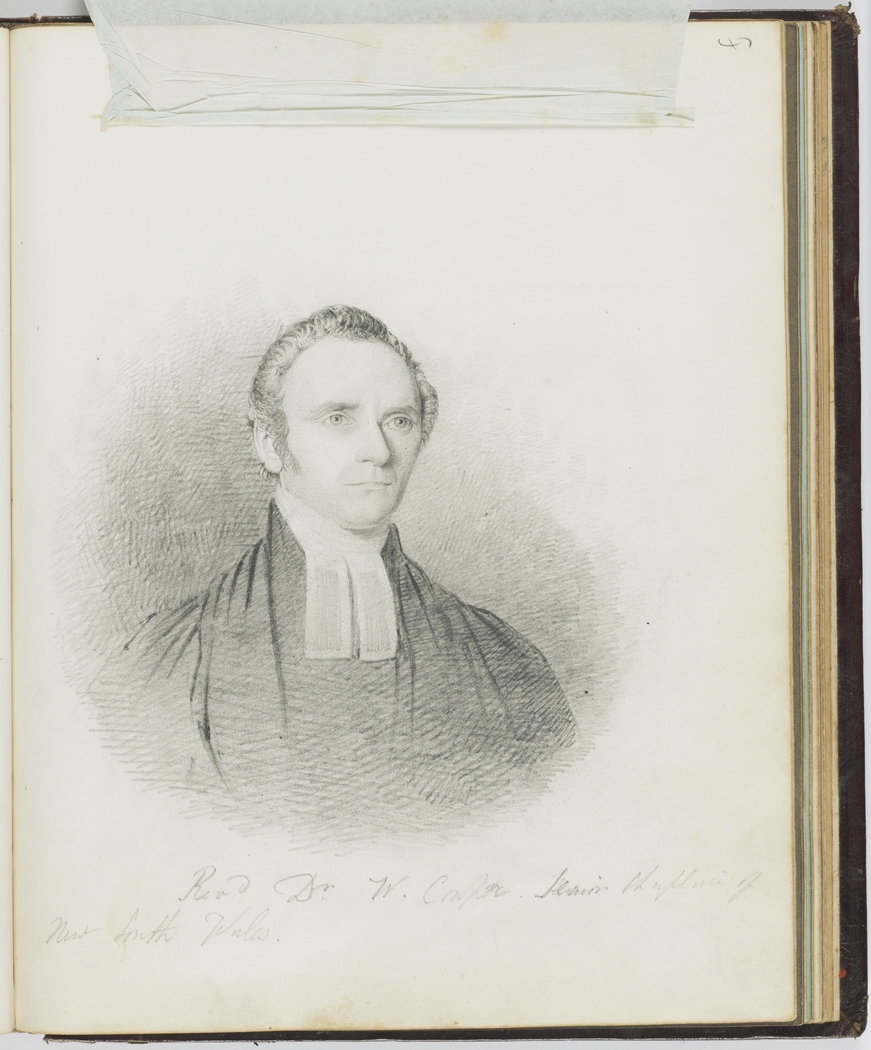Parishes and people
By 1800 the population of Sydney was approximately 2,500. In 1802 Governor King divided the colony into two parishes. Sydney Town was to be the Parish of St Philip's and the Parramatta area was to be the Parish of St John's. In 1803 the impressive St John's Church was opened in Parramatta by Reverend Samuel Marsden.
In October 1800 Rev. Richard Johnson returned to England with his family in the Buffalo. Reverend Samuel Marsden took over the role of Principal Chaplain to the colony.
Samuel Marsden's relationship with the government, and in particular, Governor Macquarie, was often difficult. Macquarie and Marsden disagreed on a range of issues. In particular, Marsden's sense of position and social order was offended by Macquarie's support of emancipists in the community. Macquarie's authoritarian style also clashed with Marsden's role as Principal Chaplain. Marsden was not allowed to introduce new versions of the Psalms which Macquarie viewed as "Methodist". He also ordered that Government notices be announced during services. As a landowner and successful farmer Marsden also objected to government control and interference in commercial activities.
In January, 1818, Macquarie summoned Marsden to Government House and in front of witnesses described him as 'the Head of a seditious low Cabal and consequently unworthy of mixing in Private society'. He commanded him to avoid his presence except upon public duty.
From 1810 a number of different denominations entered the religious landscape of the Colony. In 1803 the first authorised Roman Catholic Mass was celebrated by Father James Dixon in Sydney. Father James Dixon was one of three convict priests transported from Ireland after the 1798 Rebellion of the United Irishmen. While the numbers of people professing the Roman Catholic faith grew over time, the 1828 Census in New South Wales counted some 11,236 Roman Catholics, which was approximately 30% of the settler population.
Between 1810 and 1830 representatives from the major denominations were established in the colony. In 1818 Reverend Walter Lawry, a Methodist, arrived from England and was stationed at Parramatta. In 1820 the first appointed Roman Catholic priests, Fathers John Joseph Therry and Philip Connolly, arrived in the Colony. Also in 1820 German-born convict Joseph Marcus conducted the first Jewish service. The Presbyterian minister, Reverend John Dunmore Lang, arrived in Sydney in May 1823. The first Baptist service was conducted by Scottish Minister John McKaeg in 1831.
Before the 1820s it was accepted that the Anglican church was the established church in Australia. The Church of England worked with the State to maintain order and organise the education system. With the influx of other denominations the influence of the Anglican church diminished. The shift in power and influence created tension between the different denominations and between the church and government. Both Governors Brisbane and Darling were sympathetic to the Catholic and Wesleyan churches who provided support to free settlers and convicts. Darling's successor, Richard Bourke showed further sympathy for the role of other denominations through the Church Act of 1836 which provided financial assistance to denominations other than Anglican.
The First New South Wales census was taken in 1828. The 36,484 respondents were asked to nominate their religion as Protestant, Catholic, Jewish or 'Mohammedan and pagan'. In 1828 there were reportedly 19 people classified in the last category.
Samuel Marsden
Samuel Marsden (1764–1838) was born at Farsley, Yorkshire, England on June 24, 1764. In 1790 the Elland Society, an evangelical group within the Church of England which sponsored the education for the ministry of promising youths, sent him to Magdalene College, Cambridge. In January 1793 he accepted an appointment as assistant to the Chaplain of New South Wales. Marsden arrived in the colony on March 10, 1794 with his wife and young child.
> Read Samuel Marsden's account of the voyage out to New South Wales via the Library's catalogue
Marsden became the first rector of St John's Church Parramatta from its opening in 1803 until his death on May 12, 1838. Marsden's religious activities included the establishment of an orphanage and school in Sydney in 1801. He undertook a range of missionary activities amongst the Aborigines and organized the first Christian mission to the Maoris. He traveled across to New Zealand on a number of occasions.
This Yorkshire chaplain was a man of strong personality and deep religious conviction. He was appalled at the vice and immorality displayed by the convicts in the settlement and was determined to establish moral order in the colony. Acting as both a clergyman and civil magistrate he was at times a controversial figure. His reputation for extreme severity as a magistrate earned him the title of the "flogging parson".
Marsden was also involved in many aspects of colonial life including farming. By 1802 he had acquired 201 acres in grants and had purchased an additional 239 acres from other settlers. His holdings gradually increased to 3,631 acres by grant and 1,600 by purchase in 1827. In 1803–05 he made several reports to Governor King and to Sir Joseph Banks on the prospect of sheep breeding and wool growing.
Samuel Marsden was Senior Vice-President of the Agricultural Society which was formed on 5 July 1822. As early as 1811 he sent the colony's first commercial shipment of wool to England and continued to play a prominent role in the development of agriculture in New South Wales. This jug and stand were presented to Marsden by the Society in 1825.





Marsden and Macquarie
Samuel Marsden's relationship with the government, and in particular, Governor Macquarie, was often difficult. Macquarie and Marsden disagreed on a range of issues. In particular, Marsden's sense of position and social order was offended by Macquarie's support of emancipists in the community. For example, in 1810 Marsden refused an appointment to the board of trustees of the Parramatta turnpike road because two successful ex-convicts were also on the board. The Governor viewed his refusal as an act of insubordination. As a landowner and successful farmer Marsden also objected to government control and interference in commercial activities.
Macquarie became increasingly suspicious of Marsden's investigation and sentencing activities as magistrate and his tendency to challenge the authority of the Governor. He suspected that Marsden was sending reports back to England complaining about the administration.
In January, 1818, Macquarie summoned Marsden to Government House and in front of witnesses described him as 'the Head of a seditious low Cabal and consequently unworthy of mixing in Private society'. He commanded him to avoid his presence except upon public duty.
>View full record of Letter to Samuel Marsden, 8 January 1818 (A 797)




Men of the Cloth
Within the Library's extensive portraiture collection are the images of some of the most influential churchmen of the nineteenth century. Here is a selection of images from the Library's collections.








Made possible through a partnership with Vincent Fairfax Family Foundation
Australian Jewish community and culture
The Jewish community in Australia has made a significant contribution to the development of Australian society and culture since the establishment of the colony in 1788.




















